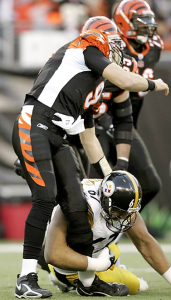Everything Football Players Need to Know about Preventing and Treating a Knee Dislocation
 Knee dislocations are not as common as other sports injuries, but they do still happen, especially in contact sports like football. In fact, football players are probably most susceptible to knee dislocations.
Knee dislocations are not as common as other sports injuries, but they do still happen, especially in contact sports like football. In fact, football players are probably most susceptible to knee dislocations.
Cincinnati Bengals quarterback Carson Palmer dealt with a knee dislocation in 2006, and Chicago Bears tight end Zach Miller experienced one during the fall of 2017.
If you or someone you love is a football player, it’s imperative that you know how to prevent and treat a knee dislocation. This is a serious injury and the better prepared you are, the greater chance you have of recovering successfully.
What is a Knee Dislocation?
A knee dislocation occurs when the bones that form the knee joint (patella, tibia, and femur, specifically) undergo a great amount of force and are pushed out of place. This is a very painful injury that is always considered emergent.
Symptoms of a Knee Dislocation
The most common signs of a dislocated knee include:
-
A loud popping sound
-
Severe pain
-
Severe bruising and swelling
You will also be able to see that a portion of the knee has been shifted out of place. There’s very little guesswork involved when it comes to diagnosing a knee dislocation.
Causes of a Knee Dislocation
In sports, there are a few situations that most commonly are responsible for a knee dislocation:
-
Colliding with another player and making contact with their knee
-
Falling and landing with the knee bent
-
Hyperextending the knee (bend it back farther than it can naturally go)
-
Sudden direction changes that cause the knee to twist in an unnatural way
Preventing a Knee Dislocation
While it’s somewhat hard to prevent knee dislocations since you can’t fully prevent the contact that often causes them, you can minimize the risk of a dislocation occurring by strengthening the muscles around the knee joint.
By strengthening these muscles, football players (and other athletes) can improve their stability and provide the knee joint with a greater amount of support.
The following are the four muscle groups that need to be strengthened to decrease one’s risk of experiencing a knee dislocation:
-
Quadriceps
-
Hamstrings
-
Glutes
-
Calves
The quadriceps and hamstrings work together to support knee flexion and extension. They’re also essential for efficient energy transfer and propelling oneself forward.
Strong glutes also help the hip joint to move properly and in a full range of motion when walking, running, and jumping. Weak glutes can lead to compensation with other muscles. This, in turn, can lead to imbalances that increase one’s risk of experiencing a knee dislocation or other injury.
Finally, strong calves also matter for supporting the knee and hip muscles from below as you walk, run, and jump.
Exercises that help strengthen these muscles and reduce the risk of a knee dislocation include:
-
Squats (bodyweight, a barbell, or dumbbells)
-
Deadlifts (with a barbell or dumbbells)
-
Hip thrusts (bodyweight, a barbell, or dumbbells)
-
Calf raises (bodyweight or with dumbbells)
-
Step-ups
Treating a Knee Dislocation
Nonsurgical Treatment Options
Some of the most common nonsurgical treatment options include:
-
Painkillers: A doctor will usually prescribe non-steroidal anti-inflammatory drugs (ibuprofen, naproxen, etc.) to help reduce pain and inflammation
-
RICE: Doctors will also, in most cases, recommend a combination of resting, icing, compressing (wrapping in a bandage or brace), and elevating the knee for additional pain and inflammation relief
-
Reduction: This occurs when the doctor will manually move the kneecap back into place in the event that it does not move on its own
-
Joint aspiration: Doctors do this to remove excess fluid from the knee joint
-
Immobilization: Most athletes have to wear a brace or immobilizing cast to stabilize their leg and prevent re-dislocation
-
Physical therapy: Physical therapy is almost always required to help athletes regain strength in the muscles around the knee joint
Surgical Treatment Options
In some cases — usually when the dislocation is so severe that it has caused extensive ligament, cartilage, or tendon damage — surgery is required. The following are the two most common types of surgery for knee dislocations:
-
Arthroscopic surgery: This involves the insertion of a small camera into the knee joint to determine the extent of the damage caused by the dislocation
-
Reconstructive surgery: This takes place after an arthroscopic surgery to remove or repair damaged cartilage. Doctors also use this type of surgery to relocate a severe dislocation or to repair tendons and ligaments
Conclusion
There’s a lot to know when it comes to preventing and treating a knee dislocation. Keep this information in mind so that you know how to keep these injuries at bay.
With these tips on hand, in the event that you or someone you know experiences a dislocation, you’ll also know what to do to minimize the damage.














